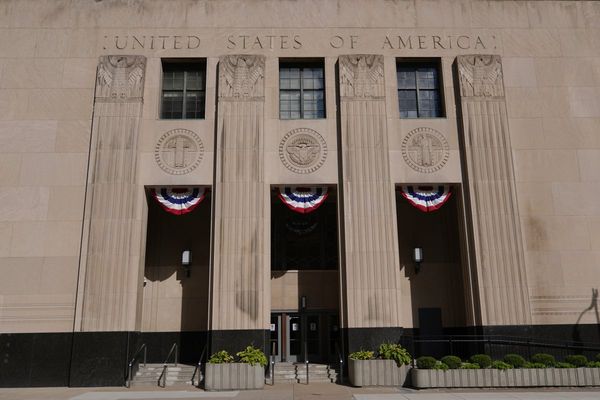The diverse political aspirations of the age had an impact on their work at all levels. The most immediately striking architectural feature of the 1951 Festival of Britain was their Skylon, a national competition-winning, 300ft-high aluminium tower. This first European example of a new American engineering technique soared skywards, with no visible means of support, a symbol of national rebirth under a Labour government keen to look beyond austerity and rationing. Winston Churchill, incoming Conservative victor of that year's October general election, insisted that it be scrapped, preferring to point to the glories of the past.
The two young architects' other great initial competition success came in 1946, and this launched the partnership. Their winning entry, for an enormous housing scheme in Pimlico, London, facing south across the Thames, showed the renewed influence of Le Corbusier and the Bauhaus, but its name was somewhat more conventionally of the period - Churchill Gardens.
The 10-storey blocks of flats were angled to leave open the views of the Thames, and three-storey terraces bordered the riverside. The idea of bringing district heating under the river from Battersea power station was a successful import from interwar Germany.
The project provided its architects with an office in Great Smith Street and work for a construction period that lasted from 1948 to 1962. During this time a mutual regard grew between the architects and their client, Westminster City Council. Powell was the strategist and planner, Moya the inventor of ingenious details and producer of beautiful drawings that were also honest and comprehensible.
As often happens, the partnership "just grew" at the Architectural Association School of Architecture in London, where the the two collaborated on a Bethnal Green housing scheme for their thesis. Powell, born in Bedford, was the son of a clergyman headmaster, under whom he studied at Epsom college. Powell won an exhibition to Cambridge to read modern languages, but a European tour exposed him to Le Corbusier's Paris buildings and the former design centre of the Bauhaus in Dessau, and he followed his elder brother Michael into architecture by going to the AA in 1939.
There he found modernist radicalism, directed towards functional design and social awareness; anticipation of the once-in-a-lifetime scope for architecture once the war and its bombing had passed; and the Californian-born, though British-bred, Moya. On graduating in 1943, they looked for a competition with which to make their mark. The drawings for Churchill Gardens were produced at 16 The Little Boltons, which remained Powell's house - he was joined there by his wife Philippa in 1953 - for the rest of his life.
The partners were often asked whose idea certain things were. Writing after Moya's death, Powell replied: "agreeably often neither of us - nor others working with us - could give an answer, there being no answer to give. This however was clear; Moya was marvellous to work with ... the design process, serious as it was, was always fun."
They approached architecture in a way that was characteristic of the early modern movement, but is seldom remembered today. They thought that originality was appropriate "only when it grows out of the originality of the problem". They mistrusted the monumental approach, "making things big when they need not be". And they did not identify with the attitude that treats any job as a "prestige job", believing that each one - large or small, repetitive or standardised - had an identity of its own and should not, in order to save its designer time and trouble, be allowed to become an arbitrary rehash of one of its predecessors.
Small wonder that they were popular with their clients. Or that the NHS should have chosen them to design its first large general hospital, although their only hospital experience at the time had been of an admissions unit at Wallingford. What immediately distinguished the Princess Margaret Hospital, Swindon (1957), was its architects' awareness that they must combine three elements: the individual needing help, the technology that could give it to him or her, and a beautiful piece of countryside.
Despite their refusal to expand beyond a size that would allow the partners to control design, and a decade of public sector work, discerning clients from other spheres of life continued to commission them. The Chichester Festival Theatre (1962) was on their drawing boards at the same time as the Swindon hospital. At the time of their Gold Medal, the Architects' Journal commented that "to work for them was a perfect school of architecture", for they had an extraordinary capacity to make spaces and textures understood. Indeed, you only have to approach the entrance of the Chichester theatre and you immediately see the point of the hexagonal plan and why the concrete frame cantilevers out.
The designers' excitement shows through just the same on more run-of-the-mill buildings. The Putney Baths (1967), with their roof of V-beams, is the best pool I ever swam in. And at Mayfield Comprehensive (1955), the school's great bulk was transmuted into spaciousness by the arrangement of low blocks round grass courts. Nothing in that building looked cheap.
A challenging commission in 1962, to create living space in a derelict backyard at Brasenose College, Oxford, led to an agreeable series of jobs in that city and at Cambridge. Christ Church's Blue Boar Court in Oxford (1967) was accompanied by a college picture gallery, which was Powell's - and most other people's - favourite Powell and Moya artefact. This ingenious, semi-buried building offers the supreme architectural enjoyment of partaking of a space, rather than just looking at it.
After Christ Church, beautifully proportioned grids of snowy concrete began to appear - at Corpus Christi, Oxford (1969), at St John's, Cambridge (1967) and at Queens' College, Cambridge (1976). At Wolfson, Oxford (1974), the graduate college on the banks of the Cherwell, one can gauge the generosity of the budget by the lightness of the designers' hearts. This shows up in the informality of the brick paved drive-in, the general feeling of spaciousness, and in the small Marble Hall.
The British Pavilion at Expo 70 in Osaka gave Moya and the structural engineer Charles Weiss an opportunity to exercise their ingenuity - and to set a fashion for masted structures. A decade later Maidstone General became the practice's favourite hospital because they were left free to design it. The long, low blocks around courts offered easy circulation, and its shallow pitched roofs were enlivened, appropriately, by the dashing design of the energy centre.
The modesty for which Powell was justly famous seemed to soak into the fabric of the buildings. Who else could have succeeded in building the Queen Elizabeth II Conference Centre (1986) in Broad Sanctuary - the very centre of pomp and circumstance - with only a single concession to the establishment's concept of what is "traditional"? I refer to the lead cladding, and I cannot imagine anyone else getting that wholly functional, concrete-framed building up, on a site exactly opposite Westminster Abbey, without a major row.
Powell enjoyed assessing competitions and discovering new talent. Although he claimed to dislike committee work, he was a member of the royal fine art commission (1969-94), and treasurer of the Royal Academy (1985-95).
He accepted many kinds of people, and they responded to him: there is no guessing how many people were delighted that he was knighted, in 1975, and was the first architect to receive the CH, in 1984. The Architects' Journal observed on that occasion that: "Modern architecture to them was not a style to impose, but an approach to a richer environment ... Those who despair of postwar building in Britain should study the evolution of Powell and Moya's work and take heart."
Moya retired in 1990, Powell in 1991, remaining as a consultant when the partnership became a limited company, and he was always on friendly terms with his successors. He is survived by his wife, son and daughter.
Arnold Joseph Philip Powell, architect, born March 15 1921; died May 5 2003







